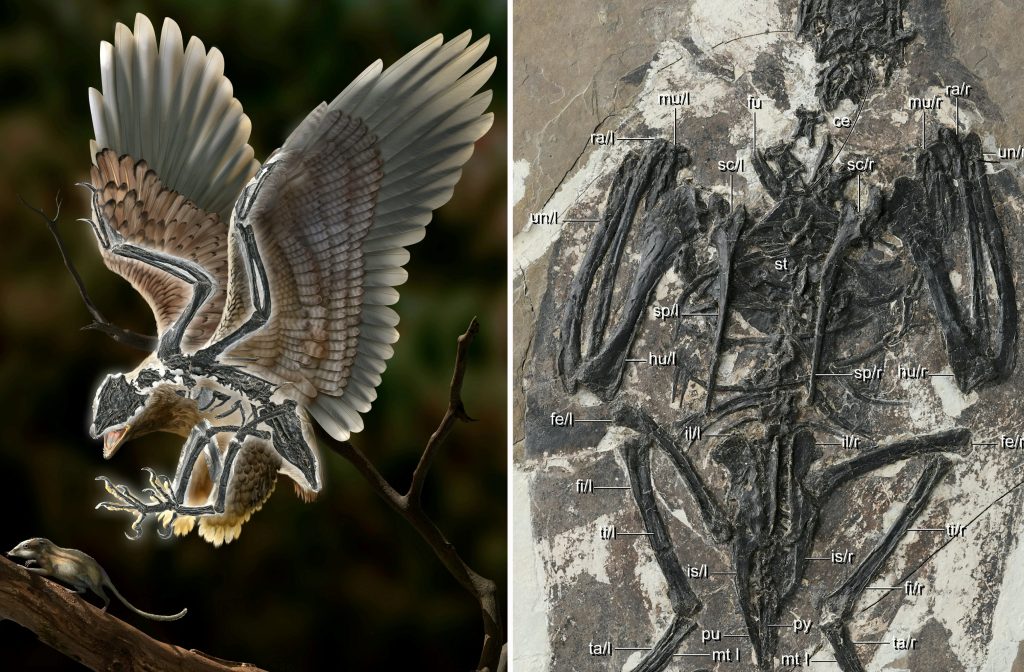
Creature Living In China Millions Of Years Ago Had Dinosaur Head, Bird's Body

A strange animal with a dinosaur head and a bird body existed in China 120 million years ago. It provides new insight into how the largest beasts to ever wander the earth gave rise to our feathered buddies.
Named Cratonavis Zhui, the chicken-sized hybrid had long shoulder blades, or scapulas, and claws.

But its large skull was shaped in an almost identical way to that of T. rex and other meat-eating theropods. The finding fills in some of the gaps as to how some dinosaurs evolved into birds.
Lead author Dr. Li Zhiheng of the Chinese Academy of Sciences, said: “The primitive cranial features speak to the fact that most Cretaceous birds such as Cratonavis could not move their upper bill independently with respect to the braincase and lower jaw.
“This is a functional innovation widely distributed among living birds that contribute to their enormous ecological diversity.”
Birds date back about 150 million years – and have been dubbed ‘living dinosaurs’. The first primitive species looked like small, feathered dinosaurs. Their mouths still contained sharp teeth. But over time, birds lost them – and evolved beaks.
Corresponding author Dr. Wang Min said: “The scapula is functionally vital to avian flight and it conveys stability and flexibility.
“We trace changes of the scapula across the Theropod-Bird transition and posit that the elongated scapula could augment the mechanical advantage of muscle for wingbone retraction and rotation.
“It compensates for the overall underdeveloped flight apparatus in this early bird, and these differences represent morphological experimentation in flight behavior early in bird diversification.”

The study found the first metatarsal – or long toe – was subjected to selection during the dinosaur-bird transition that favored a shorter one. It then lost its evolutionary lability once it reached optimal size – less than a quarter of the length of the second metatarsal.
Co-author Dr. Thomas Stidham said: “However, increased evolutionary lability was present among Mesozoic birds and their dinosaur kins.
“It may have resulted from conflicting demands associated with its direct employment of the first toe in locomotion and feeding.”
For Cratonavis, it likely stemmed from a selection advantage for catching prey. It was a carnivore that ate small reptiles, amphibians, mammals and insects. The abnormal anatomy preserved in the fossil highlights the breadth of skeletal plasticity in early birds, explained co-author Dr. Zhou Zhonghe.
He said: “Changes in these elements across the theropod tree show clade-specific evolutionary liability resulting from the interplay among development, natural selection and ecological opportunity.”
It’s now widely accepted that birds are descended from dinosaurs. The transition encompasses some of the most dramatic changes morphologically, functionally and ecologically.
It eventually gave rise to the characteristic bird body plan we see today in our gardens and forests. However, paleontologists still scratch their heads to understand how this fantastic event occurred.
Produced in association with SWNS Talker.
The Western Journal has not reviewed this story prior to publication. Therefore, it may not meet our normal editorial standards. It is provided to our readers as a service from The Western Journal.
Truth and Accuracy
We are committed to truth and accuracy in all of our journalism. Read our editorial standards.
Advertise with The Western Journal and reach millions of highly engaged readers, while supporting our work. Advertise Today.












